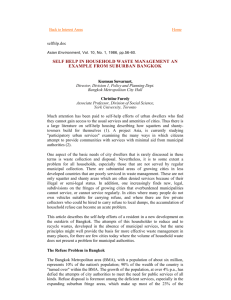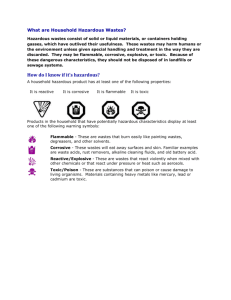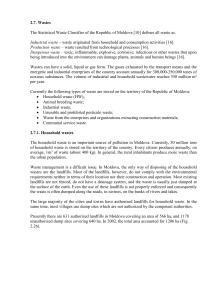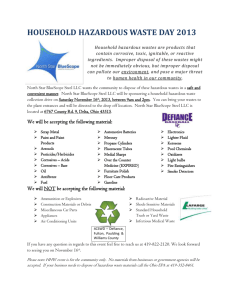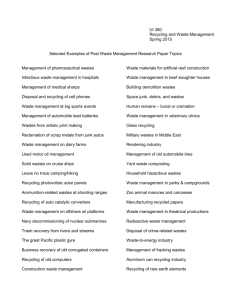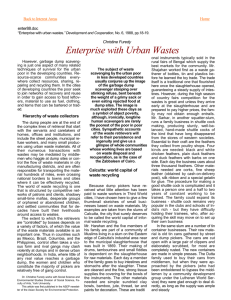Self Help in Household Waste Management.
advertisement
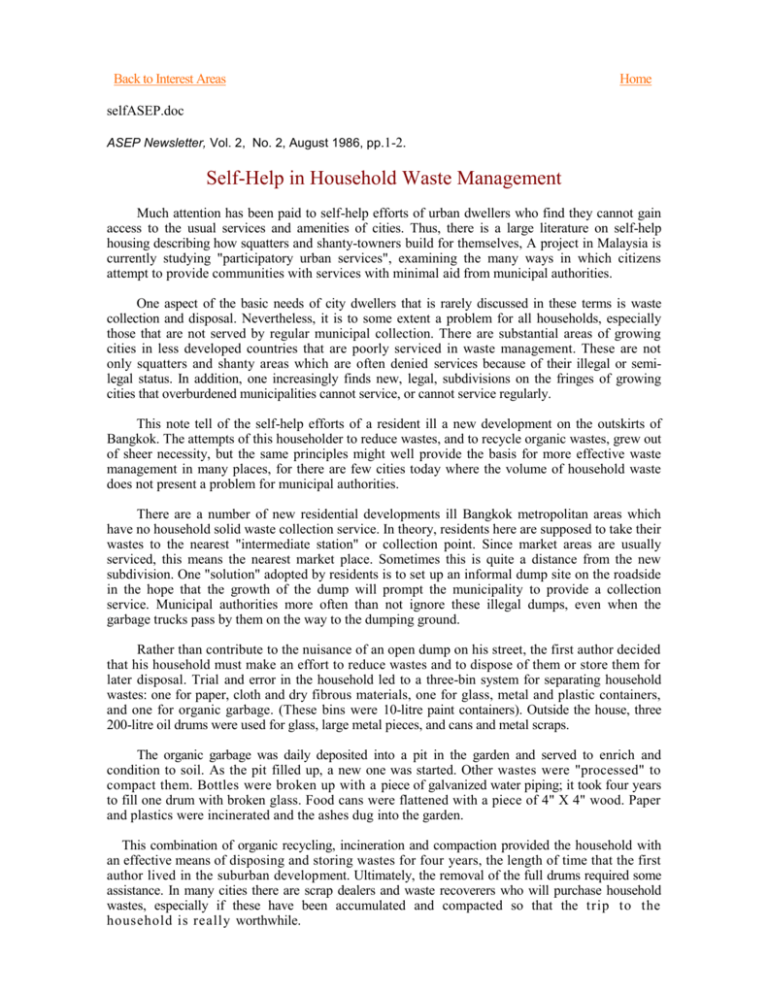
Back to Interest Areas Home selfASEP.doc ASEP Newsletter, Vol. 2, No. 2, August 1986, pp.1-2. Self-Help in Household Waste Management Much attention has been paid to self-help efforts of urban dwellers who find they cannot gain access to the usual services and amenities of cities. Thus, there is a large literature on self-help housing describing how squatters and shanty-towners build for themselves, A project in Malaysia is currently studying "participatory urban services", examining the many ways in which citizens attempt to provide communities with services with minimal aid from municipal authorities. One aspect of the basic needs of city dwellers that is rarely discussed in these terms is waste collection and disposal. Nevertheless, it is to some extent a problem for all households, especially those that are not served by regular municipal collection. There are substantial areas of growing cities in less developed countries that are poorly serviced in waste management. These are not only squatters and shanty areas which are often denied services because of their illegal or semilegal status. In addition, one increasingly finds new, legal, subdivisions on the fringes of growing cities that overburdened municipalities cannot service, or cannot service regularly. This note tell of the self-help efforts of a resident ill a new development on the outskirts of Bangkok. The attempts of this householder to reduce wastes, and to recycle organic wastes, grew out of sheer necessity, but the same principles might well provide the basis for more effective waste management in many places, for there are few cities today where the volume of household waste does not present a problem for municipal authorities. There are a number of new residential developments ill Bangkok metropolitan areas which have no household solid waste collection service. In theory, residents here are supposed to take their wastes to the nearest "intermediate station" or collection point. Since market areas are usually serviced, this means the nearest market place. Sometimes this is quite a distance from the new subdivision. One "solution" adopted by residents is to set up an informal dump site on the roadside in the hope that the growth of the dump will prompt the municipality to provide a collection service. Municipal authorities more often than not ignore these illegal dumps, even when the garbage trucks pass by them on the way to the dumping ground. Rather than contribute to the nuisance of an open dump on his street, the first author decided that his household must make an effort to reduce wastes and to dispose of them or store them for later disposal. Trial and error in the household led to a three-bin system for separating household wastes: one for paper, cloth and dry fibrous materials, one for glass, metal and plastic containers, and one for organic garbage. (These bins were 10-litre paint containers). Outside the house, three 200-litre oil drums were used for glass, large metal pieces, and cans and metal scraps. The organic garbage was daily deposited into a pit in the garden and served to enrich and condition to soil. As the pit filled up, a new one was started. Other wastes were "processed" to compact them. Bottles were broken up with a piece of galvanized water piping; it took four years to fill one drum with broken glass. Food cans were flattened with a piece of 4" X 4" wood. Paper and plastics were incinerated and the ashes dug into the garden. This combination of organic recycling, incineration and compaction provided the household with an effective means of disposing and storing wastes for four years, the length of time that the first author lived in the suburban development. Ultimately, the removal of the full drums required some assistance. In many cities there are scrap dealers and waste recoverers who will purchase household wastes, especially if these have been accumulated and compacted so that the trip to the household is really worthwhile. The principles applied to an apparently hopeless problem in this household are those that should govern waste management generally: separation at source and recycling. Some cities are already organizing their municipal services on this basis, providing households or community intermediate stations with bins for separation and setting up incentives for recycling and waste reduction. A substantial number of Japanese cities now have separate collection of wastes to facilitate recycling and one urban area, Osaka, is considering a system based on up to ten different categories of wastes. This is the "way to go" in future solid waste management. As this Bangkok example shows, citizens need not wait for the initiative of the municipality but may point to way by their self-help efforts. by Ksemsan Suwarnart (Director, Division 1, Bangkok Metropolitan City Hall) Christine Furedy (Associate Professor, Division of Social Science, York University, Toronto, and ASEP Member, Canada) Full Version Published in Asian Environment, Vol. 10, No. 1, 1986. http://www.yorku.ca/furedy/papers/wr/selfhlp.doc
